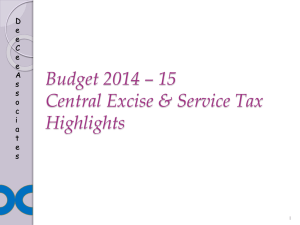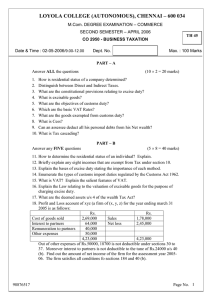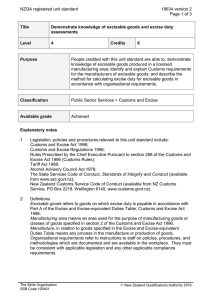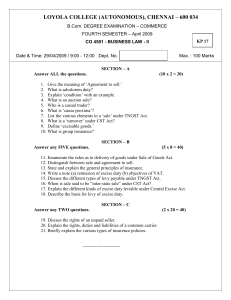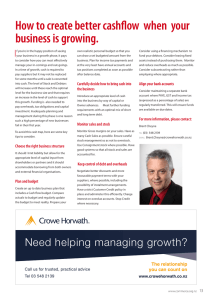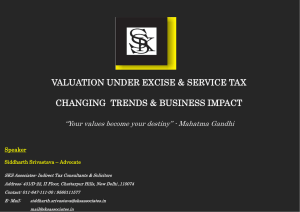CAS22: Manufacturing Cost - Institute of Cost Accountants of India
advertisement
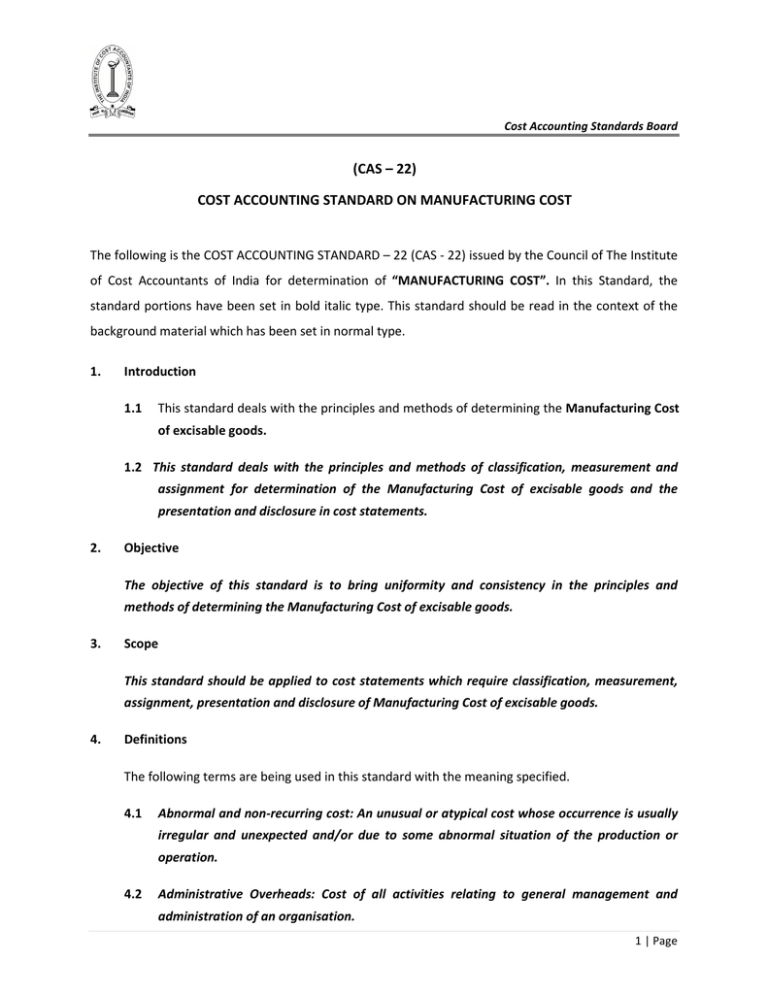
Cost Accounting Standards Board (CAS – 22) COST ACCOUNTING STANDARD ON MANUFACTURING COST The following is the COST ACCOUNTING STANDARD – 22 (CAS - 22) issued by the Council of The Institute of Cost Accountants of India for determination of “MANUFACTURING COST”. In this Standard, the standard portions have been set in bold italic type. This standard should be read in the context of the background material which has been set in normal type. 1. Introduction 1.1 This standard deals with the principles and methods of determining the Manufacturing Cost of excisable goods. 1.2 This standard deals with the principles and methods of classification, measurement and assignment for determination of the Manufacturing Cost of excisable goods and the presentation and disclosure in cost statements. 2. Objective The objective of this standard is to bring uniformity and consistency in the principles and methods of determining the Manufacturing Cost of excisable goods. 3. Scope This standard should be applied to cost statements which require classification, measurement, assignment, presentation and disclosure of Manufacturing Cost of excisable goods. 4. Definitions The following terms are being used in this standard with the meaning specified. 4.1 Abnormal and non-recurring cost: An unusual or atypical cost whose occurrence is usually irregular and unexpected and/or due to some abnormal situation of the production or operation. 4.2 Administrative Overheads: Cost of all activities relating to general management and administration of an organisation. 1 | Page Cost Accounting Standards Board Administrative overheads need to be analysed in relation to production/manufacturing activities and other activities. Administrative overheads in relation to production/manufacturing activities shall be included in the manufacturing cost. Administrative overheads in relation to marketing, projects management, corporate office or any other expense not related to the manufacturing activity shall be excluded from manufacturing cost. 4.3 Captive Consumption: Captive Consumption means the consumption of goods manufactured by one division or unit and consumed by another division or unit of the same organization or related undertaking for manufacturing another product(s), as defined in section4(3) of the Central Excise Act, 1944. 4.4 Defectives: End Product and/or intermediate product units that do not meet quality standards. This may include reworks or rejects. An intermediate product is a product that might require further processing before it is saleable to the ultimate consumer. 4.4.1 Reworks: Defectives which can be brought up to the standards by putting in additional resources. Rework includes repairs, reconditioning, retro-fitment and refurbishing. 4.4.2 Rejects: Defectives which cannot meet the quality standards even after putting in additional resources. Rejects may be disposed off as waste or sold for salvage value or recycled in the production process. 4.5 Depreciation: Depreciation is a measure of the wearing out, consumption or other loss of value of a depreciable asset arising from use, efflux of time or obsolescence through technology and market changes. Depreciation does not include impairment loss. Depreciation is allocated so as to charge a fair proportion of the depreciable amount in each accounting period during the estimated useful life of the asset. Depreciable amount of a depreciable asset is its historical cost, or other amount substituted for historical cost in the financial statements, less the estimated residual value. 2 | Page Cost Accounting Standards Board Useful life of asset is either (i) the period over which a depreciable asset is expected to be used by the enterprise; or (ii) the number of production or similar units expected to be obtained from the use of the asset by the entity. Depreciation that is charged in audited financial statement should be considered. 4.6 Direct Expenses: Expenses relating to manufacture of an excisable good, which can be identified to such excisable good other than direct material cost and direct employee cost. 4.7 Employee Cost: The aggregate of all kinds of consideration paid, payable and provisions made for future payments for the services rendered by employees of an enterprise (including temporary, part time and contract employees). Consideration includes wages, salary, contractual payments and benefits, as applicable or any amount paid or payable on behalf of employee. This is also known as Labour Cost. 4.7.1 Direct Employee Cost: The cost of employees which can be attributed to an excisable good in an economically feasible way. 4.7.2 Indirect Employee Cost: The cost of employees which cannot be directly attributed to a particular excisable good. 4.8 Interest and Finance Costs: Costs incurred by an enterprise in connection with the borrowing of funds. 4.9 Manufacturing Cost: Manufacturing cost of an excisable good is the aggregate of costs of all resources used in the process of its manufacturing. Manufacturing cost includes cost of Materials (including process materials), Employee Cost, Cost of Utilities, Packing Cost, Direct Expenses, Repairs &Maintenance Cost, Pollution Control Cost, Quality Control Cost, Research & Development Cost, Cost of Inputs received free of cost or received at concessional value from the buyer of the excisable good, Depreciation and Amortisation (including amortisation cost of free tools, patterns ,dies, drawings, blue prints, technical maps, charts, engineering, development, art work, design work, plans, sketches, packaging material and the like necessary for production of excisable goods), Cost of Rework, reconditioning, retro-fitment, Manufacturing Overheads, other 3 | Page Cost Accounting Standards Board costs allocable to such activity, adjustment for stock of work-in-process and recoveries for sales of scrap and wastages and the like but does not include expenses of the above nature incurred for post manufacturing purposes. Manufacturing Cost and Cost of Production are used interchangeably. 4.10 Manufacturing Overheads: Indirect costs involved in the manufacturing process The terms Manufacturing Overheads, Factory Overheads, Works Overheads and Production Overheads have the same meaning and are used interchangeably. Manufacturing overheads shall include administration cost relating to production, factory, works or manufacturing and depot. Manufacturing Overheads shall be classified on the basis of behaviour as Variable Manufacturing Overheads and Fixed Manufacturing Overheads. Variable Manufacturing Overheads comprise of expenses which vary in proportion to the change in volume of production. For example, cost of utilities etc. Fixed Manufacturing overheads comprise of expenses which does not change with the change in volume of production. For example, salaries, rent, repairs & maintenance, etc. 4.11 Material Consumed: Material Consumed includes materials directly identified for production of excisable goods such as: (a) Indigenous materials (b) Imported materials (c) Bought out items (d) Self-manufactured items (e) Process materials and other items (f) Materials received free of cost or at concessional value from the buyer (g) Accessories, on which cenvat credit is admissible, and which are cleared along with the final product (h) goods used for providing free warranty for excisable goods 4 | Page Cost Accounting Standards Board Cost of material consumed consists of cost of material, duties and taxes, freight inwards, insurance and other expenditure directly attributable to procurement. Trade discount, rebates and other similar items are deducted for determining the cost of materials. Cenvat credit, credit for Countervailing Customs Duty, Sales Tax set off, VAT, duty draw back and other similar duties subsequently recovered/recoverable by the entity are also deducted. 4.12 Normal Capacity is the production achieved or achievable on an average over a period or season under normal circumstances taking into account the loss of capacity resulting from planned maintenance. Capacity may be determined in terms of units of production or equivalent machine or man hours. 4.13 Packing Material Cost: The cost of material of any nature used for the purpose of packing of excisable good. 4.14 Quality Control Cost: The quality control cost is the expenses incurred relating to quality control activities for adhering to quality standard. These expenses include salaries & wages relating to employees engaged in quality control activity and other related expenses. 4.15 Repairs & Maintenance Cost: Cost of all activities which have the objective of maintaining or restoring an asset in or to a state in which it can perform its required function at intended capacity and efficiency. 4.16 Research and Development Cost: The research and development cost incurred for development and improvement of the process or the excisable good. 4.17 Royalty: Royalty is compensation/periodic payments for the use of asset (tangible and/or intangible) to the owner for use of his asset in the production/manufacture, selling and distribution by an entity. 4.18 Scrap: Discarded material having some value in few cases and which is usually either disposed of without further treatment (other than reclamation and handling) or reintroduced into the production process. 5 | Page Cost Accounting Standards Board 4.19 Technical Know-how Fee: Technical Know-how Fee is a lump sum or periodical amount payable to provider of Technical Know-how in the form of design, drawings, training of personnel, or practical knowledge, skills or experience. 4.20 Waste and Spoilage: 4.20.1 Waste: Material lost during production or storage due to various factors such as evaporation, chemical reaction, contamination, unrecoverable residue, shrinkage, etc., and discarded material which may or may not have any value. 4.20.2 Spoilage: Production that does not meet with dimensional or quality standards in such a way that it cannot be rectified economically and is sold for a disposal value. Net Spoilage is the difference between costs accumulated up to the point of rejection and the salvage value. 5. Principles of Measurement 5.1 Manufacturing cost for each excisable good shall be measured separately. 5.2 Manufacturing cost of each excisable good shall be the aggregate of direct and indirect cost relating to manufacturing activity. 5.3 Material cost shall be measured separately for each type of material, that is, for indigenous material, imported material, bought out components and process materials, self-manufactured items, accessories for each type of excisable good. Cost of Inputs received free of cost or at concessional value from the buyer of the excisable good shall be considered for determination of manufacturing cost. 5.4 The material cost of normal scrap/defectives which are rejects shall be included in the material cost of excisable goods manufactured. The material cost of actual scrap/ defectives, not exceeding the normal quantity shall be adjusted in the material cost of good production. Realized or realizable value of scrap or waste shall be deducted for determination of manufacturing cost. Material Cost of abnormal scrap /defectives should not be included in material cost but treated as loss after deducting the realisable value of such scrap / defectives. 5.5 Employee Cost for each excisable good shall be measured separately. 6 | Page Cost Accounting Standards Board 5.6. The cost of utilities consumed for manufacturing of excisable good shall be measured for each type of utility. 5.7 Packing material cost used for each type of excisable good shall be measured separately. If excisable goods are transferred/dispatched duly packed, the cost of such packing shall include cost of all types of packing in which the excisable goods are removed from the place of removal. 5.8 The Direct Expenses for manufacturing of excisable goods shall be measured for each excisable good separately. 5.9 Repairs and maintenance cost for manufacturing of excisable goods shall be measured for each excisable good separately. 5.10 Depreciation and Amortisation cost for manufacturing of excisable goods shall be measured for each excisable good separately. 5.11 Research & Development cost for manufacturing of excisable goods shall be measured for each excisable good separately. 5.12 Cost incurred for manufacturing of excisable goods after split-off point shall be measured for each Joint/By-Product. In case the manufacturing process generates scrap or waste, realized or realizable value net of cost of disposal, of such scrap and waste shall be deducted from the cost of Joint Product. 5.13 Royalty and Technical Know-how Fee for manufacturing of excisable goods paid or incurred in lump-sum or which are in the nature of ‘one-time’ payment, shall be amortised on the basis of the estimated output or benefit to be derived from the related Technical Know how. Royalty paid on sales shall not form part of manufacturing cost of excisable good. 5.14 Quality Control cost incurred in-house for manufacturing of excisable goods shall be the aggregate of the cost of resources used in the Quality Control activities in relation to each excisable good. The cost of resources procured from outside shall be determined at invoice or agreed price including duties and taxes, and other expenditure directly attributable thereto net of discounts, taxes and duties refundable or to be credited as input credit. 7 | Page Cost Accounting Standards Board 5.15 Manufacturing Overheads for excisable goods representing procurement of resources shall be determined at invoice or agreed price including duties and taxes, and other expenditure directly attributable thereto net of discounts; taxes and duties refundable or to be credited as input credit. Manufacturing Overheads other than those referred to above shall be determined on the basis of cost incurred in connection therewith. 5.16 Any abnormal cost, where it is material and quantifiable, shall not form part of the manufacturing cost of excisable good. 5.17 Interest and other Finance costs are not part of manufacturing cost of excisable good. 5.18 Manufacturing cost of excisable good shall include cost of inputs received free of cost or at concessional value from the buyer of excisable good and amortisation cost of free tools, pattern, dies, drawings, blue prints, technical maps, charts, engineering, development, art work, design work, plans, sketches, and the like necessary for production of excisable good. It shall also include cost of rework, reconditioning, retro-fitment, Manufacturing Overheads and other costs allocable to such activity, adjustment for stock of work-inprocess and recoveries from sales of scrap and wastages and the like necessary for production of excisable good. In case any input material, whether of direct or indirect nature, including packing material, is supplied free of cost or at concessional value by the buyer of the excisable good, the cost of such material shall be included in the manufacturing cost. For example: Amortisation Cost of Moulds, Tools, Dies & Patterns and Cost of Packing Material etc. received free of cost or at concessional value from the buyer of excisable good shall be included in manufacturing cost. 5.19 Any Subsidy/Grant/Incentive or any such payment received/receivable, from other entity, other than the buyer with respect to any manufacturing cost of excisable good shall be deducted for ascertainment of the manufacturing cost of excisable good to which such amounts are related. 5.20 The manufacturing cost of excisable good shall be determined based on the normal capacity or actual capacity utilization whichever is higher and unabsorbed cost, if any, shall be treated as abnormal cost. 8 | Page Cost Accounting Standards Board 5.21 Fines, penalties, damages, demurrage and similar levies paid to statutory authorities or other third parties shall not form part of the manufacturing cost of excisable good. 5.22 The forex component of imported material or other element of cost shall be converted at the rate on the date of the transaction. Any subsequent change in the exchange rate till payment or otherwise shall not form part of manufacturing cost of excisable good. 5.23 Credits/recoveries relating to the manufacturing cost, which are material and quantifiable, shall be deducted from the total manufacturing cost to arrive at the net manufacturing cost of excisable good. 5.24 Work in process/progress stock shall be measured at cost computed for different stages of completion. Stock of work-in-process/progress shall be valued at cost on the basis of stages of completion as per cost accounting principles. Opening and closing stock of work-inprocess/progress shall be adjusted for computation of manufacturing cost of an excisable good. 6. Assignment of Cost 6.1 While assigning various elements of manufacturing cost of excisable goods, traceability to an excisable good in an economically feasible manner shall be the guiding principle. The cost which can be traced directly to each excisable good shall be directly assigned. 6.2 Assignment of manufacturing cost of excisable goods, which are not directly traceable to the excisable good shall be based on either of the following two principles; 6.2.1 Cause and Effect – Cause is the process or operation or activity and effect is the incurrence of cost. 6.2.2 Benefits received – to be apportioned to various cost objects in proportion to the benefits received by them. 6.3 The variable manufacturing/production overheads shall be absorbed based on actual production. 6.4 The fixed manufacturing/production overheads and other similar item of fixed costs such as quality control cost, research and development costs and administrative overheads 9 | Page Cost Accounting Standards Board relating to manufacturing shall be absorbed in the manufacturing cost on the basis of the normal capacity or actual capacity utilization of the plant, whichever is higher. 6.5 In case a production process results in more than one product being produced simultaneously, treatment of joint products and by-products shall be as under: 6.5.1 In case joint products are produced, joint costs are allocated between the products on a rational and consistent basis. 6.5.2 In case by-products are produced, the net realisable value of by-products is credited to the manufacturing cost of the main product. 6.6 Miscellaneous Income relating to production/manufacture shall be adjusted in the determination of manufacturing cost. For example, income from sale of empty containers used for procurement of raw material shall be deducted in determination of manufacturing cost. 7 Presentation 7.1 Cost statement as per Appendix 1 to this standard or as near thereto shall present following information: 7.1.1 Actual capacity utilization in absolute terms and as a percentage of normal capacity. 7.1.2 Cost information relating to various elements of Cost shall be presented separately. 8. Disclosures 8.1 Disclosure shall be made only where material, significant and quantifiable. 8.2 If there is any change in cost accounting principles and practices during the period under review which may materially affect the manufacturing cost of excisable good in terms of comparability with previous period(s), the same shall be disclosed. 10 | Page Cost Accounting Standards Board 9. Effective date This Cost Accounting Standard shall be effective from the period commencing on or after 1st April 2015 for being applied for the preparation and certification of Cost Accounting Statements for excisable goods. 11 | Page Cost Accounting Standards Board Appendix 1 Cost Statement showing Manufacturing Cost of (Name of excisable good) for the period: __________________ Name of the Manufacturer Address of the Manufacturer Excise Registration Number Name of the unit Address of the unit Central Excise Tariff Heading A Quantitative Information Unit Quantity Amount Cost per Unit 1 Normal/Installed Capacity 2 Production 3 Captive Consumption 4 Production as %age of Normal/Installed Capacity B Cost Information Unit Quantity Rate Materials (specify) 1 A. B. C. D ….. Total Materials Consumed 2 Process Materials 3 Utilities 4 Direct Employee Cost 5 Direct Expenses 6 Consumable Stores and Spares 7 Repairs and Maintenance Cost 8 Quality Control Cost 9 Research & Development Cost 12 | Page Cost Accounting Standards Board B Cost Information Unit Quantity Rate Amount Cost per Unit 10 Technical Know-how Fee/Royalty, if any 11 Depreciation/Amortization 12 Other Manufacturing Overheads 13 Total(1 to 12) 14 Add/Less Work-in-Progress Adjustments 15 Less Credit for Recoveries , if any 16 Packing Cost 17 Cost of Inputs Received Free or at concessional value from the buyer of the excisable good 18 Manufacturing Cost (13 to 17) Date: Seal & Signature of the Company’s Authorised Representative I/We have verified above data on test check basis with reference to the books of account, cost accounting records and other records. Based on the information and explanations given to me/us, and on the basis of generally accepted cost accounting principles and practices and Cost Accounting Standards followed by the entity, I/we certify that the above cost data reflects true and fair view of the manufacturing cost of the above excisable good. Date: Place: Seal & Signature of Cost Accountant Membership No.: Firm Regn. No.: Note: Separate Cost Statement(s) shall be prepared for each excisable good ***** 13 | Page
